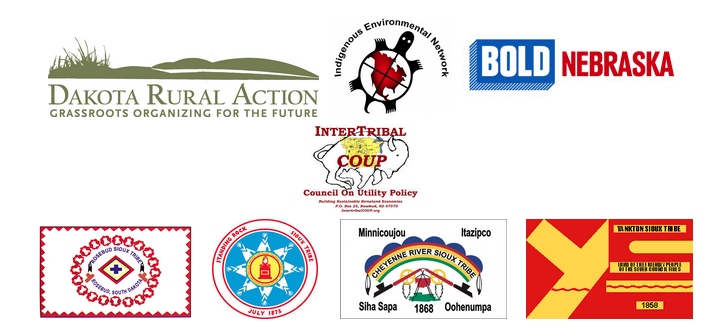

For Immediate Release: July 31, 2015
Contact:
Thomasina Real Bird, Attorney for Yankton Sioux Tribe, 612-840-7635
Matthew Rappold, Rosebud Sioux Tribe, matt.rappold01@gmail.com, 605-828-1680
Tracey Zephier, Attorney for Cheyenne River Sioux Tribe, tzephier@ndnlaw.com, 605-347-1265
Peter Capossela, Attorney for Standing Rock Sioux Tribe, 541-505-4883
Bob Gough, Intertribal Council on Utility Policy, 605-441-8316
Lewis GrassRope, Lower Brule Sioux Tribe, 605-208-0880
Dallas Goldtooth, Indigenous Environmental Network, goldtoothdallas@gmail.com, 507-412-7609
Sabrina King, Dakota Rural Action, sabrina@dakotarural.org, 605-939-0527
Jane Kleeb, Bold Nebraska, jane@boldnebraska.org, 402-705-3622
In South Dakota, TransCanada Faces Serious Challenges on Keystone XL
Pierre, SD – As rumors have been flying around the Beltway about a decision coming soon on the controversial proposed Keystone XL tar sands pipeline, the battle over the pipeline’s permit in South Dakota rages on, and it’s not looking good for TransCanada.
Hearings taking place this week before the state Public Utilities Commission about the impact of the pipeline and whether or not it’s needed will determine whether TransCanada can continue to meet the 50 conditions upon which the 2010 permit was based. The contentious hearings have now been extended through the weekend and into next week.
Questions have arisen about TransCanada’s track record of safety issues along its pipelines. Issues like dramatic corrosion along the Keystone I line, portions of which are corroded up to 96.8% through the pipeline wall, call into serious question the company’s claims that Keystone XL would not pose a threat to land and drinking water for millions of people. One of TransCanada’s top engineers, Meera Kothari, who is not licensed in the United States, testified that Keystone I was safe, in her opinion, despite the 14 leaks within the first 12 months of its operation.
“Even one spill is too many, much less 14,” said Joye Braun, individual intervener and member of the Cheyenne River Sioux Tribe. “This proves that the threat to South Dakota is just too much to bear. The safety of our states resources including our drinking water, wildlife, livelihoods as farmers and ranchers, and cultural resources must be protected.”
To make matters worse, as the Mitchell Republic reports, the amount TransCanada claimed it would pay to the state in property taxes seems to be dramatically inflated. Given the discrepancy between the amount the company estimated it would pay along the Keystone I route and what it has actually paid, interveners at the South Dakota hearing argued that TransCanada has no way to prove they would pay the whopping $20 million in property taxes they claim.
Not only that, the hearings took a contentious turn when, after one of TransCanada’s witnesses was asked about the market demand for Keystone XL given low oil prices, the company’s lawyers asked the Commission if they could withdraw their witness and strike his testimony, rather than answer uncomfortable questions about the need for more tar sands pumping through America’s heartland. In an extremely irregular move, the Commission allowed the withdrawal, limiting the scope of its review so as to protect TransCanada from reasonable citizen questions.
The events of this week in South Dakota highlight, once again, that TransCanada has been deceptive in its fight to build Keystone XL and that the company is unable to prove that the pipeline could be operated safely.
With no current legal route through Nebraska or South Dakota and questions mounting about the project, prospects for Keystone XL are bleak. That’s good news for Americans and for the climate.
###



